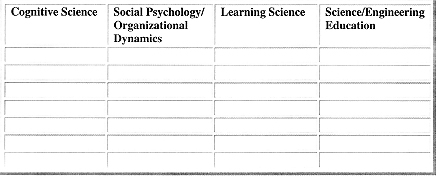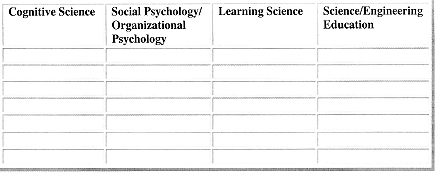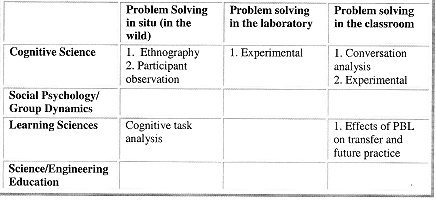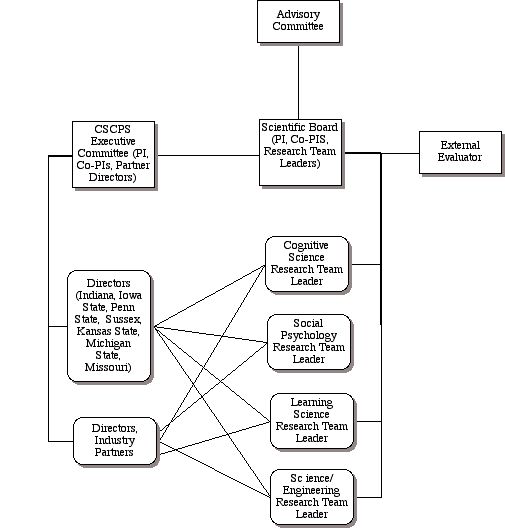Nature of Problems
Vision
Why Problem Solving?
Partners
Research on Problem Solving
Management Plan
Intellectual Merit
Broader Impact
Catalyst Grant Activities
References
We propose to establish a Science of Learning Center to be known as the Center for the Study of Problem Solving (CSPS) to conduct world-class research on the nature of problem solving performed by STEM workers in the workplace, the laboratory, and the classroom. Our primary goal is to advance the knowledge about problem solving processes across the STEM fields, however, the emphasis in the first five years will be on engineering problem solving. We plan to assemble an outstanding team of researchers who will define and execute research agendas related to complex problem solving in engineering. This original approach will integrate the activities of researchers who have never worked together in order to collaboratively define our research agendas. We also have assembled an advisory board and management plan that will enable us to insure the effectiveness of the different research teams.
We propose to explore STEM problem solving initially in three different contexts from three different perspectives. We propose to research problem solving in the workplace ("in the wild," after Hutchins, 1995), problem solving in the laboratory (examining basic psychological processes involved in solving problems), and learning to solve problems in the classroom. Problem solving in these contexts will be researched from the perspectives of cognitive science, social psychology/group dynamics, and the learning sciences, including engineering and science education. The research conducted in these venues will employ a mixture of research methodologies, including ethnographies, cognitive task analysis, experimental research, and other qualitative methodologies such as participant observation and interviews. The integrated efforts of all of the researchers will inform design research on technology-enhanced learning environments and classroom pedagogies in STEM classrooms, with emphasis on the participation of underrepresented groups in STEM programs. We believe that the most meaningful outcomes will likely result at the intellectual intersections of different contexts and theoretical perspectives, so we intend to articulate those goals and agendas.
The overarching intellectual goal of the Center is to better understand how STEM workers solve workplace problems including the kinds of reasoning, social interactions, and collaboration that are required to solve them. The overarching impact of the Center is to better construct and research learning environments and classroom pedagogies required to better prepare the next generation of engineers and STEM workers to successfully solve workplace problems. The objectives of the CSPS include:
- Analyze and explicate the nature of problem-solving practices in engineering and other STEM workplaces.
- Based on STEM problem-solving activities, articulate a multi-disciplinary research program on problem solving and assemble diverse teams of researchers from different contexts, domains, and intellectual perspectives.
- Develop partnerships with cognitive science, social psychology/group dynamics, learning sciences (including engineering and science education) researchers to articulate and execute programs of research on STEM problem solving.
- Identify other researchers from non-partnership programs around the world who provide important and unique research perspectives and assemble all of the researchers into research team who will conduct research on engineering and STEM problem solving.
- Develop partnerships with industries in order to articulate critical problem-solving skills and to transfer pedagogical and technological solutions developed by the Center.
- Develop partnerships with engineering and STEM programs in universities and conduct professional development activities with professors and research pedagogical and technological solutions developed by the Center in engineering and other STEM classrooms.
These goals are supported by a Science of Learning Catalyst Grant from the National Science Foundation (NSF). The primary goal of this grant is to develop a full center proposal, which will be submitted to NSF in 2005. Currently, we are building a coalition of partners, including university research programs and affiliated researchers from around the world with expertise in cognitive science, social psychology, group dynamics, learning sciences, and engineering and science education. The Catalyst Grant is support the initial analysis of engineering workplace learning by constructing case libraries of engineering problems and problem-solving research that will be used to orient the final proposal. . In addition, the project is also building an open-architecture, web-based authoring environment for embedding a wide range of ill-structured problems in order to support learning Finally, the grant will support a workshop being held in Breckinridge, Colorado in September, 2004, at which the partners will begin the process of articulating research agendas and developing working relationships.
The research that we propose is an example of use-inspired research (Stokes, 1997), which involves the dynamic interplay that integrates the basic research performed by cognitive scientists and social psychologists in laboratory settings with the more applied research conducted by all of the researchers in situ and in classrooms. The research is inspired by the need to improve the abilities of a generation of engineers, so the impact of this research can be tested only in classrooms and workplaces. Yet the goals of the research are basic: scientific understanding of problem solving.
[up]
STEM workplace learning is the focus of the Center. STEM workplaces require engineers and scientists to solve a variety of complex problems. While university students in STEM disciplines, including engineering, frequently solve problems in their academic programs, those problems are inconsistent with the nature of problems that engineers and STEM workers solve in the workplace. Classroom problems are usually well-structured story problems whereas scientists and engineers in the workplace are almost always required to solve complex and ill-structured problems. Well-structured classroom problems require the application of a finite number of concepts, rules, and principles being studied to a constrained problem situation that has a well-defined problem space, known solution paths, and correct, convergent answers. Workplace problems are almost always ill-structured because they have divergent solutions, require the integration of several content domains, possess multiple solutions, solution paths, and multiple criteria for evaluating solutions.
Researchers have long assumed that learning to solve well-structured problems, like story problems, transfers positively to le solving ill-structured problems that are situated in practice. However, Dunkle, Schraw, and Bendixen (1995) concluded that performance in solving well-defined problems is independent of performance on ill-defined tasks, with ill-defined problems engaging a different set of epistemic beliefs. Hong, Jonassen, and McGee (2003) also found that solving ill-structured problems in a simulation called on different skills than well-structured problems, including metacognition and argumentation. Communication patterns and problem-solving processes differed when solving well-structured and ill-structured problems (Cho & Jonassen, 2002; Jonassen & Kwon, 2001). Although more research s needed, it is clear that the ability to solve story problems does not transfer to solving real-world, ill-structured problems that have many alternative solutions, vaguely defined or unclear goals and constraints, multiple solution paths, and multiple criteria for evaluating solutions.
Learning to solve complex, ill-structured problems (e.g., design, decision-making, and diagnosis-solution) during their education is important for STEM students because they need to develop transferable problem-solving skills. Individually solving well-structured story problems engages and requires only "sequestered problem solving" (Bransford & Schwartz. 1999), where learners apply a limited set of principles without access to resources. We have conducted research that has shown that solving well-structured story problems does not adequately prepare learners for solving the kinds of ill-structured problems that they will encounter in the workplace. Therefore, we believe that CSPS research and activities should focus more on the "preparation for future learning" (PFL) view of transfer. PFL enables students to encounter everyday problems with the skills, knowledge, and predilections to represent and structure the problem situations, access and use relevant resources, test solutions, and reflect on their efforts in order t work smarter (Bransford & Schwartz, 1999). In some disciplines, students are exposed to everyday problems in capstone courses. However, these experiences are inadequate for preparing students for working on the kinds of team-mediated, problem solving that they will encounter in the workplace. More experiences with the cognitive entailments and social dynamics of workplace problems will better prepare engineering students for practice.
Although the CSPS will examine problem solving in all STEM contexts, engineering problem solving has been chosen as the initial emphasis for Center research for the following reasons. First, it is necessary to establish boundaries for research on problem solving. Problem solving is so pandemic in our modern society that it is impossible for any single center to address the entire domain of problem solving. While the Center plans to investigate problem solving in multiple STEM workplaces (e.g., sciences, mathematics, medicine, and computer sciences), the first five years will emphasize engineering in order to have greater impact on learning among engineering students. Second, while most professional workers regularly engage in problem solving, for workplace engineers, problem solving represents the predominant, if not exclusive, form of professional activity of engineers. Workplace engineers, as much or more than any other profession, are hired, rewarded, and retained for their ability to solve a variety of complex, ill-structured problems, including decision-making, diagnosis, and especially design problems. Perhaps the most compelling reason to focus problem-solving research on engineering is that engineers are problem solvers. Occupational studies have shown that nearly every task that engineers engage in involves problem solving, so engineers represent an appropriate testbed for examining complex engineering. Third, undergraduate engineering programs are inadequately prepared to engage and support students in learning to solve the kinds of ill-structured regularly encountered by professional engineers. In most engineering colleges, faculty lack the professional engineering experiences that enable them to prepare students for solving complex, workplace problems. Although most engineering program require capstone courses involving simulated workplace problems, there is inadequate emphasis on complex problem solving throughput the curriculum. Fourth, the Accreditation Board for Engineering Technology (ABET, 2000) specifies the ability to identify, formulate, and solve engineering problems as the most essential learning outcome for any engineering program. Fifth, educational reform efforts are more prominent among engineering programs than most other STEM disciplines. The engineering education partners involved in this proposal provide evidence of that commitment. There are far more engineering education centers worldwide than any other STEM discipline.
[up]
Research on problem solving has been hampered by the absence of research centers devoted to that study. Research on problem solving has always been distributed among institutions and departments, with the bulk of research emanating from individual researchers in psychology, engineering, and the sciences. Most researchers who focus on problem solving function in relative isolation, most commonly by individuals supported by one or two research assistants. To date, no attempt has been made to integrate the activities of these distributed individuals. That is the primary goal of CSPS. Given the nature of research on problem solving, the members of the research teams are distributed internationally, rather than concentrated at a few institutions. The goal of the Center is to attract the most highly qualified and respected researchers to participate in the articulation and conduct of research on problem solving.
According to NSF, the most important predictor of the success of any Science of Learning Center is the strength of its partners. The Center for the Study of Problem Solving will have three kinds of partners.
- Research Teams (Cognitive Science, Social Dynamics, Learning Sciences, and Engineering Education) will comprise research groups from different universities who will design, conduct, and report research on problem solving in situ, in the laboratory, and in the classroom. These two research groups will include social psychological/group dynamics researchers and cognitive science researchers. They will identify and research the key cognitive and social issues in problems solving.
- Industrial Partners will provide access to STEM workforce for understanding of workplace problems, support the analysis of problem solving activities, and implement and test performance support systems and learning environments that support problem solving in situ.
[up]
Role of context
Contemporary theories of situated learning, constructivism, everyday cognition, and social cognition (Jonassen & Land, 2000) has convinced us that the context in which learning and cognitive activity occurs constrains the nature of the thinking and the activity. The research on problem solving will be conducted by teams of researchers. During the Breckinrdge Workshop, we will identify the researchers who will be investigating problem solving in the different contexts listed in Table 1a. Likewise, we will be articulating the research questions that will be investigated by these researchers in Table 1b.
 |
Table 1a Researchers responsible for conducting research on problem solving in different contexts |
 |
Table 1b Research questions that will drive research on problem solving in different contexts |
Role of Domain
Contemporary research and theory on problem solving argue that problem-solving skills are also domain specific, that is, problem-solving activities are situated, embedded, and therefore dependent on the nature of the problems solved within different domains. This is because solving problems within a domain relies on cognitive strategies (strong methods) that are specific to that domain (Mayer, 1992; Smith, 1991; Sternberg & Frensch, 1991). Lehman, Lempert, and Nisbett (1988) concluded that different forms of reasoning are learned in different graduate disciplines. For example, graduate students in the probabilistic sciences of psychology and medicine perform better on statistical, methodological, and conditional reasoning problems than students in law and chemistry, who do not learn such forms of reasoning. The reasoning is learned through the development of pragmatic reasoning schemas rather than exercises in formal logic. That is, students in these domains develop reasoning skills through solving situated problems that require forms of logic that are domain-specific. The CSPS proposes to conduct research in a variety of scientific domains in order to investigate the specificity of reasoning and knowledge representations in different domains. During the Breckinridge Workshops, we will decide which researchers are associated with different scientific domains and will be conducting research in those domains listed in Table 2a. Like wise, we will describe research questions that will be investigated by these researchers in Table 2b.
 |
Table 2a Researchers whose research focus addresses different domains |
 |
Table 2b Research questions that will drive research on problem solving in different domains |
Role of Research Perspectives
Just as the research questions in various scientific domains differ, so too will the questions asked by teams of researchers. The perspectives that are relevant to studying complex, workplace oriented problem solving and learning how to perform it are cognitive science, social psychology/organizational dynamics, learning sciences, and science/engineering education. Any overlap in these perspectives is intentional and desirable. Although many Science of Learning Centers include significant neuroscience perspectives in understanding learning, no neuroscience research has ever addressed tasks as complex as those addressed by this proposal. The technologies for investigating brain functions are not adequate for articulating brain functions during complex problem solving. Tables 3a and 3b will identify the researchers identifying with each of the perspectives and the research questions they have generated in Breckenridge and afterward.
 |
Table 3a Researchers from different perspectives |
 |
Table 3b Research questions from different perspectives |
Another dimension of problem-solving research focuses on the problem-solving functions. While the cognitive and social entailments of various kinds of problems differ, there are generic problem-solving functions that underpin most kinds of problem solving. These functions include problem representation, solution generation, solution evaluation, social collaboration, etc. Different researchers will address different functions of problem solving.
What the CSPS seeks to identify are the conceptual connections at the crossroads of context, domain, and perspective. The CSPS will make every effort to develop research agendas that call on the strengths of combinations of researchers. Integrating research from different perspectives will result in new research agendas Table 4 lists some of the research questions that have been articulated by combinations pf researchers. Table 5 lists the research methodologies that they plan to apply to answering the research questions in Table 4.
 |
Table 4 Research questions representing conceptual connections at research crossroads |
 |
Table 5 Research methodologies used to investigate the conceptual connections at the intersection of research agendas |
[up]
The effectiveness of the CSPS will depend on the organization and communication of participants and activities. Management of CSPS is made more problematic by the distributed nature of the enterprise. There exist nowhere in the world research centers dedicated to the study of problem solving, as with other research foci. Therefore, research responsibilities in CSPS must be distributed among multiple partners, each fulfilling one or more research roles. The participants and resources of the CSPS will be managed according to the organizational plan described in Figure 1.
 |
Figure 1 Organization of CSPS |
In order to manage the distributed nature of research activities in the CSPS, redundant layers of management are necessary. Fiscal, logistical, and personnel issues will be addressed by the Executive Committee, which consists of the PI, Co-PIs, and the site directors. Site Directors will be identified at each research site consisting of four or more researchers and each industrial partner. Therefore, fiscal responsibility will be site-based. Subcontracts will be issued to each site based on the proposed activities of the members at that site. This team will enable the Industrial Partners to remain closely allied with the different Research Partners. All research-related issues will be addressed by the Scientific Board, which consists of the PI, Co-PIs, and the Leaders of the four different research teams. These teams consist of researchers from all of the institutions who share common research agendas. The leader of each research team will coordinate the research activities of each research team and will also meet every three months with The Scientific Board.
Communication among the participants in the CSPS will be facilitated in two ways: a knowledge management system and consistent and continuous communication and collaboration among the participants.
The knowledge management system will collect, store, and make accessible all documents, decisions, and collaborations of the CSPS.
Communications will also include monthly meetings of the Executive Committee, quarterly meetings of the Scientific Board, and annual meeting of the Research Teams to share and review results and adjust research agendas. The results of the research will also be disseminated at professional society meetings and through publication in refereed research journals and books.
[up]
This catalyst proposal seeks to establish a state-of-the-art Science of Learning Center focusing on professional problem solving in engineering. The Center plans to analyze and conduct use-inspired research on problem-solving processes conducted by engineers. It is essential that we better understand the nature of the problems that all STEM workers and other professionals solve in the workplace before we can prepare students to solve them.
The Center will investigate workplace problem solving from four scientific perspectives: cognitive science, social psychological/group dynamics, learning sciences, and engineering education. Problem solving is a quintessentially cognitive process. Explicating the cognitive and metacognitive requirements for solving different kinds of problems encountered in engineering workplaces is necessary, but not sufficient for better preparing students. In professional work contexts, engineers rarely, if ever, solve problems individually. Rather, engineers must collaborate with myriad other workers in complex teams, posing serious social, organizational, and cultural risks and further complicating the nature of the problem solving. Research ahs shown that the social dynamics of workplace problem solving are frequently the greatest impediment to success for professional engineers.. Therefore, the CSPS will also examine engineering problem solving from the perspective of social psychology and group dynamics.
[up]
Growing out of the cognitive, social dynamics, and learning science research on problem solving, the Center will also analyze workplace problem solving and conduct design research that will build and iteratively test learning systems and activities in university classrooms to better prepare undergraduates students to become better problem solvers. The learning science and engineering education researchers will collaborate with the cognitive and social psychology researchers to implement and test innovative learning systems in university classes and industrial workplaces that will better prepare pre-service and engineering workers.
Researchers will interact with practicing engineers and STEM workers while examining and better understanding problem-solving activities in workplace contexts. In addition to designing state-of the-art learning systems, the Center seeks to foster fundamental changes in engineering and STEM programs in universities by providing professional development activities to prepare engineering faculty to effectively prepare their students for solving workplace problems. The goal of all of these activities is to prepare university graduates to solve complex and ill-structured problems.
Better understanding workplace, laboratory, and classroom problem solving in the STEM disciplines will support the following intellectual and societal impacts:
- Reform of undergraduate science and engineering curricula in university programs.
- Reform of pedagogies and instructional strategies used by faculties in science and engineering programs in universities
- Development and dissemination of technology enhanced learning environments to support learning in science and engineering courses in universities.
- Development and enhancement of faculty teaching skills in science and engineering faculty members in universities around the country.
- Training and intellectual preparation of Ph.D. researchers capable of investigating problem solving from cognitive, social dynamic, and learning science perspectives.
- Training and intellectual preparation of designers of innovative, problem-based learning environment that can be used in science and engineering classes around the world
- Development of research capacity in STEM problem solving.
[up]
In addition to producing a proposal for a full Science of Learning center (due October-November, 2004), the personnel working on the Catalyst grant will also produce the following:
- Problem Solving Digital Library, including
- Inventory of STEM Problems - descriptions of problem-solving tasks performed by STEM workers in diverse workplace settings. These problems will be indexed and made accessible through a case-based reasoning retrieval engine.
- Bibliography of relevant problem solving research, with individual research studies also accessible through a case-based reasoning retrieval engine.
- Open-ended, web-based authoring tools for representing and supporting complex and ill-structured problem solving.
[up]
Bransford, J.D. & Schwartz, D. (1999). Rethinking transfer: A simple proposal with multiple implication. In A. Iran-Nejad & P.D. Pearson (Eds.), Review of research in education (Vol. 24, pp. 61-100). Washington, DC: American Educational Research Association.
Cho, K.L., & Jonassen, D.H. (2002). The effects of argumentation scaffolds on argumentation and problem solving. Educational Technology: Research & Development, 50 (3)5-22.
Dunkle, M.E., Schraw, G., & Bendixen, L.D. (1995, April). Cognitive processes in well-defined and ill-defined problem solving. Paper presented at the annual meeting of the American Educational Research Association, San Francisco, CA.
Hong, N.S., Jonassen, D.H., & McGee, S. (2003). Predictors of well-structured and ill-structured problem solving in an astronomy simulation. Journal of Research in Science Teaching, 40 (1), 6-33.
Jonassen, D.H.& Kwon, H.I., (2001). Communication patterns in computer-mediated vs. face-to-face group problem solving. Educational Technology: Research and Development, 49(10), 35-52
Hutchins, E. (1995). Cognition in the wild. Cambridge, MA: MIT Press.
Lehman, D., Lempert, R., & Nisbett, R.E. (1988). The effects of graduate trainining on reasoning: Formal discipline and thinking about everyday-life events. Educational Psychologist, 43, 431-442.
Mayer, R.E. (1992). Thinking, problem solving, cognition (2nd ed.). New York: Freeman.
Smith, M.U. (1991). A view from biology. In M.U. Smith (ed.), Toward a unified theory of problem solving. Hillsdale, NJ: Lawrence Erlbaum Associates.
Stokes, D.E. (1997). Pasteur's quadrant: Basic science and technological innovation. Washington, DC: Brookings Institute Press.

